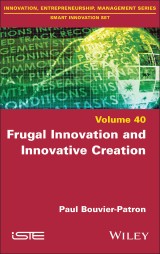Details

Frugal Innovation and Innovative Creation
1. Aufl.
|
142,99 € |
|
| Verlag: | Wiley |
| Format: | |
| Veröffentl.: | 15.08.2023 |
| ISBN/EAN: | 9781394236794 |
| Sprache: | englisch |
| Anzahl Seiten: | 368 |
DRM-geschütztes eBook, Sie benötigen z.B. Adobe Digital Editions und eine Adobe ID zum Lesen.
Beschreibungen
<p><b>Businesses and enterprises can no longer avoid the concern of their Natural Environmental impact, which calls into question their economic activities.</b></p> <p><i>Frugal Innovation and Innovative Creation</i> is at the crossroads of economics and management in business, particularly focused on innovative enterprises and their interactions with the Natural Environment. Navigating these interactions can be perceived by companies as a costly constraint, especially in an innovation process, which is already very expensive.</p> <p>The aim of this book is therefore to highlight the need for a satisfactory technology level while innovating, without risking damage to the Natural Environment. The challenge here is to propose a form of frugal innovation that is likely to be successful, while also mindful of the environmental considerations from the outset, hence the concept of environmental frugal innovation.</p> <p>Furthermore, by questioning the practice of innovative creation (especially if it integrates the ideas of respect for and preservation of the Natural Environment), this book reveals the importance of two key elements that are present regardless of the modality (the level of technology and organization): improvisation and bricolage.</p>
<p>Introduction ix</p> <p><b>Chapter 1 Natural Environment, Positive Private Goods and Consequentism 1</b></p> <p>1.1 Management of negative externalities 12</p> <p>1.1.1 Managing irreversible negative externalities: trade and markets, governance and choice 13</p> <p>1.1.2 Decentralized regulation 22</p> <p>1.2 Private decision and consequentism 23</p> <p>1.2.1 Consequentism 25</p> <p>1.2.2 Internalization of consequentism as the best remedy 26</p> <p>1.2.3 Consequentism for the technological object and the adopter's system of objects 31</p> <p>1.2.4 Carbon accounting: solution or illusion? 33</p> <p>1.3 Positive private goods and consequentist calculation 41</p> <p>1.3.1 Positive private good 42</p> <p>1.3.2 Methodological comparison 45</p> <p>1.3.3 Discussion on the applicability of the calculation 46</p> <p>1.4 Conclusion 50</p> <p><b>Chapter 2 FabLab: Creation and Design through Technology? 53</b></p> <p>2.1 The major form of contemporary industrial organization 57</p> <p>2.1.1 The network form: NoF 57</p> <p>2.1.2 The virtual form: extension of the NoF via ICT 60</p> <p>2.2 FabLab: heterogeneous form or NoF reinforcement? 63</p> <p>2.2.1 Definition of FabLab 63</p> <p>2.2.2 FabLab and NoF compatibility 66</p> <p>2.3 From extended NoF to the beginnings of a potential new industrial dynamic? 69</p> <p>2.4 Conclusion 73</p> <p><b>Chapter 3 Communitization of Technological Innovation: The Value and the Symbolic 77</b></p> <p>3.1 New technological products: inter-organizational networks, business ecosystems and innovative communities 78</p> <p>3.2 Places where innovation is created, practices of innovative communities, managerial and symbolic issues 83</p> <p>3.2.1 Places and practices of innovative communities 83</p> <p>3.2.2 Managerial issues of innovative communities 85</p> <p>3.3 Virtualization and symbolic value in relation to its uses 88</p> <p>3.3.1 Shift from value to symbolism 91</p> <p>3.3.2 Systematized symbolic logic and community marker 94</p> <p>3.4 Conclusion 96</p> <p><b>Chapter 4 Technology and Symbolic Spectacle of Marking by Use 99</b></p> <p>4.1 Community and virtualization: what individuation? 104</p> <p>4.1.1 Activist practices of virtual communities and mimetic rivalry: viral marking 105</p> <p>4.1.2 Limited otherness in the virtual immersion of the community self 110</p> <p>4.2 Performance of immersive symbolic projection by marking the community self within the virtual community 112</p> <p>4.2.1 From the technological offer to the symbolic marketing of the virtual self: avatar and the profession of the self 113</p> <p>4.2.2 Role dream symbolism and marking the community self 116</p> <p>4.3 Conclusion 119</p> <p>4.3.1 Exceeding: beyond the virtual 120</p> <p>4.3.2 Virtual influencer: an illustration by the case of Lil Miquela 122</p> <p><b>Chapter 5 Back to Common Sense: Towards Frugal Environmental Innovation (FEI) 133</b></p> <p>5.1 Definition and place of frugal innovation (FI) 135</p> <p>5.1.1 Frugal innovation: contextualization and definition 135</p> <p>5.1.2 Conceptual place of frugal innovation 138</p> <p>5.2 Double challenge of the western firm: competitive and environmental advantage 140</p> <p>5.2.1 Strategic scenarios 140</p> <p>5.2.2 Environmental competitive advantage and frugal environmental innovation 142</p> <p>5.3 Conclusion 145</p> <p><b>Chapter 6 From Environmental Innovation (EI) to Frugal Environmental Innovation (FEI) 147</b></p> <p>6.1 Environmental innovation (EI) 149</p> <p>6.1.1 Corporate proactivity and EI 151</p> <p>6.1.2 Proactivity and creativity: green entrepreneurship 152</p> <p>6.2 Types of actors and diffusion of EI 153</p> <p>6.2.1 Summit of the EI actor typology: creative and proactive 154</p> <p>6.2.2 EI dissemination 155</p> <p>6.3 Proposal of a strategic matrix to innovate 156</p> <p>6.3.1 Irreversibility of negative externalities 157</p> <p>6.3.2 Logic of sophistication and/or frugal approach? 158</p> <p>6.3.3 Opting for frugal environmental innovation (FEI) 161</p> <p>6.4 Conclusion 162</p> <p><b>Chapter 7 Bricolage and Improvisation: Two Key Cogs of Innovative Creation 165</b></p> <p>7.1 Bricolage as a concept 168</p> <p>7.1.1 Bricolage: a new concept but an old practice 168</p> <p>7.1.2 Is bricolage a matter of logic? 169</p> <p>7.1.3 Bricolage and the current application of the concept 170</p> <p>7.2 Bricolage as a key device for innovative creation 171</p> <p>7.2.1 Bricolage and improvisation 172</p> <p>7.2.2 Bricolage and frugal innovation 176</p> <p>7.2.3 Synthetic view: conceptual map of innovative creation 179</p> <p>7.3 Conclusion 181</p> <p>Conclusion 185</p> <p>Appendices 189</p> <p>Appendix 1 191</p> <p>Appendix 2 219</p> <p>Appendix 3 221</p> <p>References 235</p> <p>Index 271</p>
<p><b>Paul Bouvier-Patron</b> is a lecturer and member of CERGAM, France. He is interested in the link between innovation management and sustainable development. His research focuses on the idea of an environmental frugal approach based on creativity, co-creation, improvisation and bricolage.</p>


















